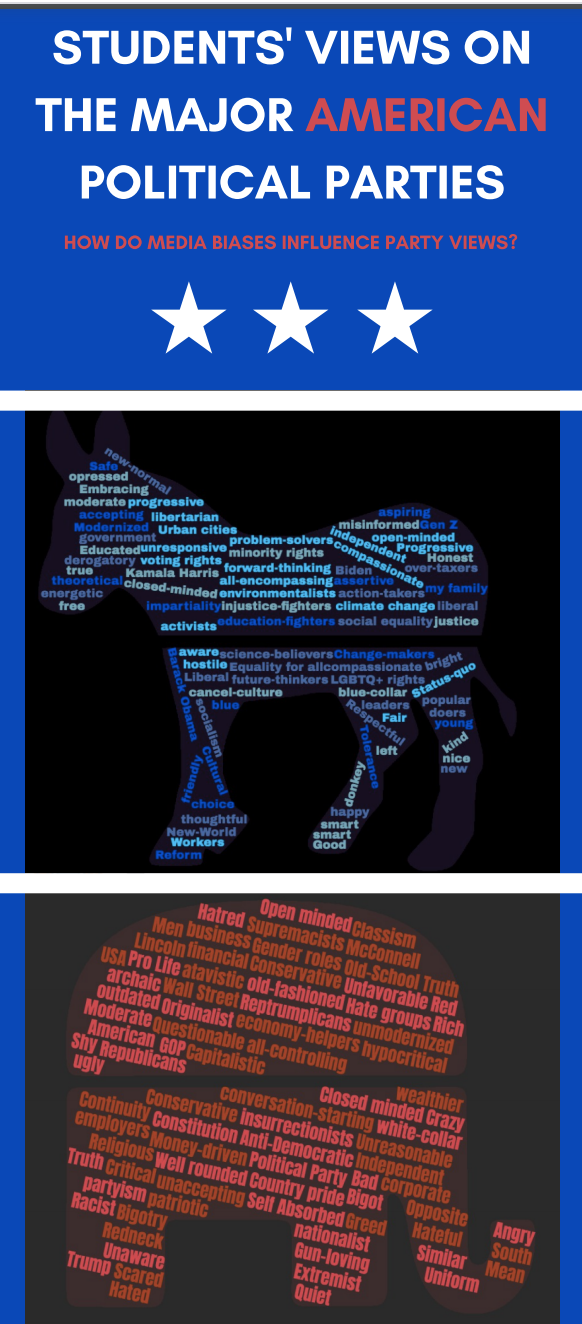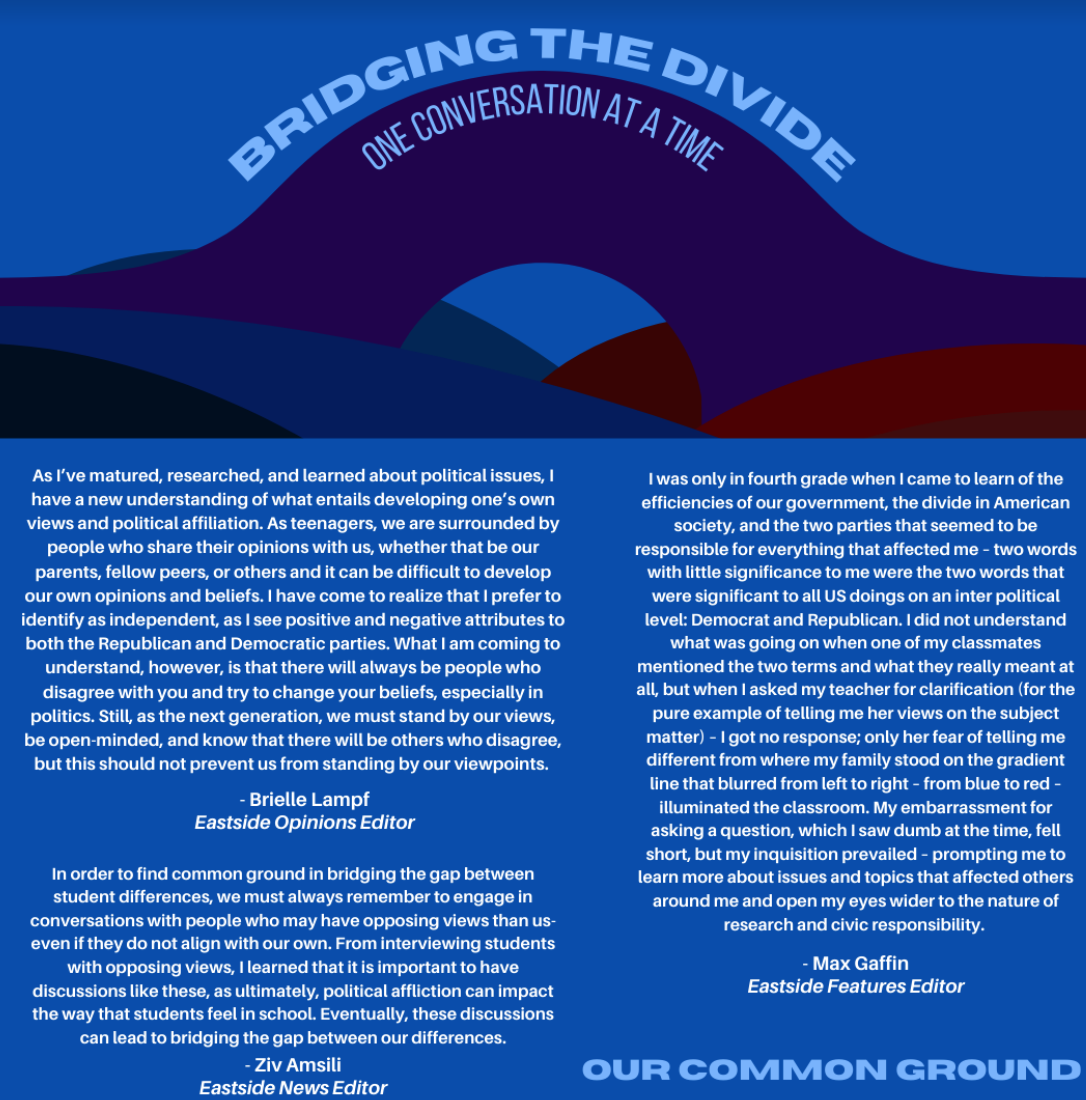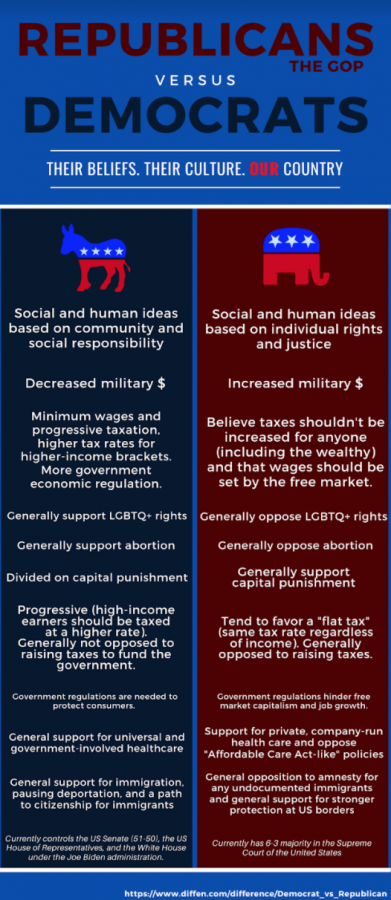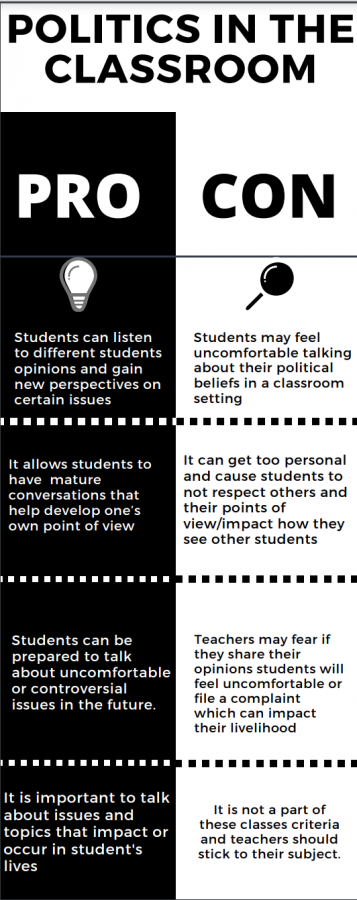Political divides grow wider locally and nationally
April 10, 2021
Our political climate has been increasingly polarizing. At a time when the middle ground seems non-existent, it is hard to speak about political views and current hot topics and issues. At a time when America, known across the world as the United States, seems more divided. At a time when you may be classified as educated or unaware, your knowledge may reflect your character. In this package, we will dive into the causes of this issue and see how the political polarization seeps into our life as Cherry Hill High School East students. We will find how politics are taught and how they should be taught. In the midst of these tense times, bringing up facts and actual events like the recent Capitol attacks, the 2020 Election, conflicting tensions between Democrats and Republicans, a 50/50 split Senate, new voter suppression laws, a heavily conservative and originalist-viewing Supreme Court, and inhumane legislative policies make some feel uneasy. In a time when facts and feelings blur, the place for politics, as well as current events in the classroom, is uncertain. In a time when humanitarian and social matters are deemed political. How can we trust the media? How do we teach politics to students of divided households? How do we learn of who to vote for and where to find our own beliefs?
Causes of political polarization
Democrats v.s. Republicans
Through the spread of mass media and the news, two words, thatwords that used to be limited to two terms on an election ballot for public officers in high office, now are two of the most widely used and criticized words of all time. Consistently dominating the political landscape, Democrats and Republicans, make up the two-party system in the United States and conflict head-on-head with their beliefs and ideas for reform. Many, only know about the two parties from the collateral damage they have caused or from the confirmation bias they witness in the media, making them unable to make up their own beliefs or find their fit because of the pressure they face in their communities- red or blue.
Associated with more progressive policies, the Democratic Party favors greater government intervention in the economy and opposes government intervention in private noneconomic affairs of citizens. Originally being the party that tolerated slavery in the pre-Civil War era of America’s divided history, the Democratic Party reinvented themselves and found new beliefs that centered around the support for organized labor, the civil rights of minorities, social welfare, and progressive reforms. Modern-day Democrats follow the New Deal-era progressive past of social equality and equal opportunities for all, supporting further voting rights, minorities, LGBTQ+ rights, environmental protection programs, gun control, alleviating immigration laws, abortion, and worker rights.
However, conflicting with almost the direct opposite as the blue Democrats, Republicans, also known as members of the Grand Old Party (GOP), support lower taxes, free-market capitalism, restrictions on immigration, increased military spending, gun rights, restrictions on abortion, deregulation, individual health care, and restrictions on the many US labor unions. Many Republicans and people of conservative values see individuality and the liberty that allows as the fundamental truth of America’s democracy.
In the US government, the two major political parties’ responsibilities to their constituents and their core beliefs come to the mainstage. When finding your individual beliefs, make sure to understand the candidates you are voting for and the policies that the candidate will bring with them.
The media’s portrayal of political parties affects students’ views at East
In a survey sent out to Cherry Hill East students, they were asked to respond in one word on how they view the Republicans and Democrats. The blunt answers generalize the students’ overall view and impression of each party. One major influence of the responses is most likely social media because of its large influence on every aspect of teen life, especially how teens view news.
Our country has been extremely polarized lately. One aspect of life that has changed in recent years is the evolution of technology, which includes the development of social media. Social media was created as a tool so grandparents could view pictures their grandchildren and to connect with old friends. Somewhere along the way, the lines of social media have been blurred, and it is no longer a tool, but a business.
The goals of these companies is to keep people on their apps as long as they can so they curate the users’ feeds to what they like. This means when it comes to politics users rarely see posts on their feed with which they disagree or challenge their beliefs. In addition, people begin to see nothing right with the other side when every bit of news or opinions confirms their own biases. Social media is a tool that can bring us together but also has the power to create a larger divide.

Filtering political views
From the view of a conservative at East:
This junior’s political beliefs first started during the 2016 election, when he conducted his own research about the parties that ran for office and made his own decision, though it may have not been in line with the beliefs of most of his friends and parents.
Although his beliefs may oppose his friends’, family’s, or even state’s political demography, he says that he likes the diversity of political affiliations pertaining to people in his personal life, whether it be speaking with people on their views, or following news outlets that have dissenting opinions.
“Something that I would like to do is run for public office of some sort and if I’m in an area where it’s 60% [liberal] and 40% [conservative] I am not going to win. That’s why I want to relate to my community, where the sides are [relatively equal] and everyone can come together and talk about [their opinions]”
Despite this, he feels he must be specifically careful about some political topics because he does not want to say anything that can be taken out of context. Additionally, he feels that this sentiment can be taken to what he publicly showcases online and says “Specifically online I feel like I have to step around my own thoughts even though they aren’t hateful thoughts”.
In the classroom setting, he prefers to keep his views neutral, if not hidden, because he feels that some teachers do not speak objectively about political topics. He says that though teachers may not openly say what they think, they display their political affiliations indirectly, such as having liberal news articles on their wall, or wearing their political party’s clothing.
“School should not be a place where you go and a teacher tries to teach you how to think politically” and it should not be biased one way or the other… sophomore year I had a teacher who thought that socialism was great and how she would love to be taxed double to pay for free [college] education, and I don’t think that was the right place to be talking about politics”
Nonetheless, the student says that he tries his best to look at both sides of every single topic and then come to a decision. He does not have right winged sentiments on every currently debated subject, and says that there are some grey areas in his beliefs. He is inclined to listen to other peoples’ opinions on political subjects that he does not fully understand, and in doing so, says that these conversations add to his views.
Furthermore, he does believe that the country is divided, and that people nowadays do not engage in political discussion because they “don’t want to hear the other side” of topics.
Ultimately, though he finds it beneficial to engage in discussions with friends and family who have differing views than him, he does not believe that his political affiliations should hinder him from speaking his mind. He says that teachers should do a better job at narrating objective truths without displaying side commentary about their opinions.
From Lauren Perry (‘22)’s point of view, she feels that speaking about her own political views is something that has gotten easier for her over the past year. Her political beliefs also started in the 2016 election, and have become more profound over time.
Perry says, “My political views started with the 2016 election. I was a very strong democrat and recently in the 2020 election, I’ve definitely shifted further left but definitely in favor of strong economic reform, if not a complete overhaul of how we operated the country politically and economically”.
Ultimately, this belief led her to avidly post on her social media accounts in the spring and summer with relation to nationally recognized events.
She says, “In the summer I had people replying to my stories denying these pretty objective truths, in my opinion”. Perry says that her political views are pretty clear cut, but she is still working on educating herself on topics that she is not fully familiarized with.
In the classroom setting, Perry says that she is very comfortable speaking with her teachers about her political views and states that she feels she has a stronger connection to her teachers due to their relatability in political affiliation.
Perry says, “I’m very comfortable with my teachers. Sometimes I email my history teacher and say ‘listen… this capitalism thing isn’t working for me.’”
Perry states that in the classroom setting however, teachers are as objective as they can be. “We discuss historical things… not so much modern events that we talk about. I think that a lot of teachers are careful because they can get in trouble for speaking on their political views”, she says.
Furthermore, she thinks that when serious events happen that deserve to be brought attention to, like the storming of the capital for instance, teachers bring up these events, but mostly just give their opinions about historical events.
Perry says that her and her friends generally have the same views about big political issues, and if that’s not the case, they usually engage in a friendly debate over their beliefs, and says that she feels comfortable about engaging in debates with conservatives. Despite this, she feels that she would not befriend people who have significantly different views than her own.
“I feel like politics are really your morals and actions and that is embodied in how we vote….I’m not going to form connections with people I disagree with on big issues”, she says.
Subsequently, though Perry knows that some people may object to her posts on her instagram story, she feels that she can speak openly both in the classroom setting and online, as she says that she’s always been a very political person, and wants her voice to be heard.
How politics divide families and friends
Americans have never been more divided. Whether in looking at statistics on polarization or just by interacting with other people, the impacts of this division can be seen and felt across the nation. As those impacts intensify, they also extend their reach. Today in America, friends and families, as well as more distant acquaintances, are being torn apart by political division.
Politics have always been a source of strife in the United States. After all, this nation was born from a series of political disputes. Still, recent years have seen more disunity than ever. Recent research has found that 90% of Americans now view their country as divided over politics and 60% feel pessimistic about our ability to overcome such divisions to solve problems. Meanwhile, the number of Americans who feel “very unfavorable” towards their political opponents has grown three-fold since 1994. These statistics all demonstrate that not only do people feel divided by politics, but many also feel that such division is too significant to overcome.
These increases in polarization among regular Americans align with a similar increase among leaders. While politics has always been a divided space, only recently has it been common for Americans to hold entirely different worldviews based on what leaders tell them to believe. Basic facts, like the results of an election, had never before been called into question as they were in 2016 and 2020. To see members of Congress verbally accosting each other was unheard of for a long time. Now, it’s happened at least twice in just the last year. Supporting wild conspiracy theories alleging that Democrats are actually part of a pedophilic cabal was once reserved for fringe believers, not actual members of Congress. It’s hard not to see a connection between all of these changes and changes in Americans’ level of division.
All of this extends to families and friends in harmful ways. Unfortunately, little data exists on how families specifically are being divided by politics. However, reporting from sources like the New York Times has offered a window into the real-life impacts of these large-scale changes. This reporting has told stories of families broken by politics. Among those interviewed, some hadn’t even spoken to family members since the 2016 election. Among those who still spoke, that speaking often came in the form of screaming matches or painful arguments. Meanwhile, others tried to ignore politics entirely when it came to family. With politics becoming more and more ubiquitous in American life, though, that can be difficult, too. No matter how it’s approached and dealt with, politics is often hurting the relationships of those who disagree.
When it comes to friendships and romantic relationships, more concrete evidence of a widening rift is available. YouGov polling showed that from 2016 to 2020, the number of Americans who had no friends with very different political beliefs nearly tripled, going from 7% to 19%. When it comes to romantic relationships, the division is even starker. The “Singles in America” report, a survey of 5,000 Americans conducted in 2020 by the dating company Match, found that 52% did not believe they could have a relationship with someone with very different political views. That number has increased by 15% in the last eight years. It’s clear that more and more, Americans feel they cannot be close in a number of ways with people who have different political views.
All of this information points to a new reality coming in America. People are living in different political realities. Hate and fear are becoming more and more common political tools. Extreme beliefs are becoming common ones. With all of that being true, it’s no wonder that families and friends are more divided than ever. If something big in politics doesn’t change soon, more and more relationships likely will.
Politics in the classroom
Every day, students and teachers walk into their schools, oblivious to the change and impact that their government plays in shaping the education they are given or give. From school board elections to the education branch of our executive government, educational policy and curriculum are formatted. On both sides of the political spectrum, opinions about schools are established– whether they relate to increasing funding, instituting mandatory classes, bond referendums, opportunities outside the classroom, the responsibility of public schools to communities, and where educational control lays. Nonetheless, in the end, students will receive an education from their educators 一 an education that would have been impacted by policy from both Republicans and Democrats on the state and national level.
As recent events unfolded from May of last year to now, much controversy has sparked on topics such as humanitarian and moral values and those of political affiliation – which makes people question where to draw the line between the two. Though many incidents have resulted in giving greater attention to related movements, prompting discussion among family members and friends, or simply being more aware of an individual’s relationship between his/herself and his/her community, many have argued that these events garnering national recognition may infiltrate what people deem as moral/immoral as coming to be politicized and those topics which are simply founded on a political basis come to be moral issues.
It is important to note where the line is drawn between talking about politics, humanitarian social justice issues, and just teaching impartial about what happens in US politics. However, every conversation starts and every major event that is uncovered will affect students depending on how such controversies are taught, who teaches them, and the biases both the teachers and students have already established.
In a survey Eastside conducted, 62.5% of East students said that the discussions stemming from political topics should be conducted objectively, whereas teachers should teach students about politics and historical events, without inputting some sort of bias. 37.5% of students expressed the beliefs that teachers should express their concerns, issues, and views with what is going on in the current political atmosphere 一 especially if such concerns, issues, or views stem from modern hot topics, pressing humanitarian social justice claims, or unfortunate events that are currently popular in US society, economy, and culture. From those surveyed, no students believed that politics and other political issues shouldn’t be taught in school.
Although there is a divide in America between political beliefs, education is one of the most pressing concerns for all parties. It is important to properly and effectively teach mathematics, English comprehension, history, new 21st century skills, and leadership qualities, as the education taught today will shape the future of America’s landscape. Continue to read about how political education is challenged and taught in schools like Cherry Hill East today.
Avoiding biases when teaching: Interview with Mr. Rosenberg
Max Gaffin (’22) and Brielle Lampf (’23) talk to Mr. Thomas Rosenberg about biases while teaching and how to maintain impartiality.
Avoiding biases when teaching: interview with Ms. Mason
Max Gaffin (’22) and Brielle Lampf (’23) talk to Ms. Christine Mason about biases while teaching and how to avoid personal beliefs in teaching history.
Becoming involved in politics locally
Even as far back as the 1980s, the rhetoric in Congress was becoming increasingly incendiary. The 2016 election, however, dramatically increased the divisiveness in American politics. Not only globally, but around the dinner table and in Cherry Hill schools, more people began to discuss politics, which led to heated debates with friends and family. Whereas prior to the 2016 election, politics may not have seemed like it had a direct impact on most peoples’ daily lives, the 2016 Presidential candidates had such a polarizing effect that people now understand that what happens in Washington DC can be felt in Cherry Hill, New Jersey and all over the country.
Since that time many people who were not previously interested in politics have noticed that politicians take staunchly different positions on issues such as the Black Lives Matter movement, abortion rights, climate change, gender rights, the COVID-19 crisis, taxes, gun control, and which judges to appoint to the Supreme Court. People understand that their votes count, and even if a candidate wins by a small margin, he or she can make radical changes that affect our lives.
Based on election results, it appears that roughly half the country identifies as conservative and the other half identifies as more liberal. Slight changes in voting habits can sway an election and change the country’s direction. Those who have opinions on how the country would be best served should become active in local politics.
Fortunately, Cherry Hill and our local area provides many opportunities. One way to become involved is to help with voter registration. Another way is to join an organization who supports a particular cause. In addition, individuals may contact their local city council and federal and state representatives and even attend town council meetings. Attending school board meetings, starting a blog, volunteering for a campaign, and attending rallies are other ways to promote certain causes. Many Facebook groups exist that support political action.
There are countless organizations spanning a variety of issues. A few of these include:
Camden County Democrat Committee https://www.camdencountydemocrats.com/?fbclid=IwAR3Hfn4zRUv4BSu0iLHEApsg9629G5fzFoYc5Qyk31d4NCNz0bQufTciSE0
This organization supports candidates for public office who are aligned with Democratic strategies.
Camden County Republicans
https://camdencountyrepublicans.com/
This organization supports candidates for public office who are aligned with Republican strategies.
South Jersey Women for Progressive Change
https://sjwpc.weebly.com/ This group works to empower and educate women to fight for progressive change and end oppression.
4. https://www.lwvccnj.org/ League of Women voters of Camden County
This organization of men and women aims to protect voting rights and encourage widespread participation in elections and government.
5. http://www.pridefund.org/ Pride Fund to End Gun Violence
This political action committee supports candidates who support policies designed to end gun violence while protecting LGBTQ safety and equality.
6. https://njcaef.org/?page_id=718 New Jersey Citizen Action Education Fund
This nonprofit organization aims to empower low and moderate income individuals by educating them on public policy issues, such as climate change, etc.




